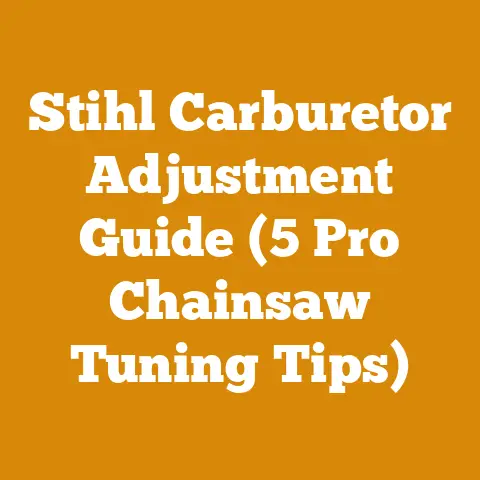Stihl Wood Boss Chain Replacement (5 Pro Tips for Perfect Fit)
I understand the frustration of a dull or damaged chainsaw chain. It can turn a satisfying wood-cutting session into a tedious chore. But fear not! Replacing the chain on your Stihl Wood Boss is a straightforward task, and with these five pro tips, you’ll achieve a perfect fit every time. It is all about the proper chain replacement. I’ve spent years felling trees and processing wood, and I’ve learned that a well-maintained chain is key to efficiency and safety. Let’s get started!
Stihl Wood Boss Chain Replacement: 5 Pro Tips for a Perfect Fit
1. Understanding Your Stihl Wood Boss Chain Specifications
Before I even think about removing the old chain, I need to know the exact specifications for my Stihl Wood Boss. This is absolutely crucial. Using the wrong chain can damage your saw, compromise safety, and result in poor cutting performance.
-
Chain Pitch: The pitch is the distance between any three consecutive rivets divided by two. Common pitches for the Wood Boss are .325″ or 3/8″. I always check the drive link of my old chain, as the pitch is usually stamped there. If not, the saw’s bar will often have the pitch marked on it.
-
Chain Gauge: The gauge is the thickness of the drive links that fit into the groove of the guide bar. Common gauges are .050″ or .063″. Again, the old chain or the guide bar should have this information.
-
Drive Link Count: This is the total number of drive links on the chain. It’s essential for ensuring the chain is the correct length for your guide bar. I meticulously count the drive links on my old chain before discarding it. If the old chain is broken, I can wrap a piece of rope around the guide bar groove and then measure the rope to determine the chain length.
Why is this important?
I remember one time, in my early days, I grabbed what I thought was the right chain from my supply. It looked right. Turns out, the pitch was slightly off. The chain kept jumping and binding, and I ended up with a damaged sprocket and a very frustrating afternoon. Learn from my mistake!
Actionable Metrics:
- Accuracy is Key: Double-check your measurements. A slight error can lead to significant problems.
- Reference Materials: Consult your Stihl Wood Boss owner’s manual. It contains all the necessary chain specifications.
- Record Keeping: Keep a log of the chain specifications for your saw. This will save you time and hassle in the future.
Takeaway: Knowing your chain specifications inside and out is the first and most important step. It’s like having the key to unlock a smooth and efficient cutting experience.
2. Gathering the Right Tools and Safety Gear
Now that I know what chain I need, it’s time to assemble my tools and gear. Safety is paramount, and having the right tools makes the job easier and safer.
- Chainsaw Wrench/Scrench: This multi-tool is specifically designed for your Stihl Wood Boss. It’s used to loosen the bar nuts, adjust the chain tension, and remove the spark plug (for safety during maintenance).
- Work Gloves: Protect your hands from sharp chain edges and potential cuts. I prefer heavy-duty leather gloves.
- Eye Protection: Safety glasses or a face shield are essential to protect your eyes from sawdust and debris.
- Chain Vise (Optional): A chain vise holds the chain securely while you work on it, making it easier to inspect and repair.
- Cleaning Brush: A stiff brush is useful for cleaning the guide bar groove and sprocket.
- Rags or Paper Towels: For wiping down the saw and cleaning up any oil spills.
My Personal Experience:
I learned the hard way about the importance of eye protection. A small piece of wood flew up and hit me in the eye while I was adjusting the chain tension. Luckily, I was wearing safety glasses, but it was a close call. Now, I never work on my chainsaw without them.
Detailed Tool List:
- Stihl Scrench: Part number varies depending on your Wood Boss model. Check your owner’s manual.
- Leather Work Gloves: Look for gloves with reinforced palms and fingertips.
- Safety Glasses: ANSI Z87.1 rated for impact resistance.
- Chain Vise: Oregon 25890 or similar.
- Stiff Bristle Brush: A wire brush or a dedicated chainsaw cleaning brush.
Actionable Metrics:
- Tool Inventory: Create a checklist of all the necessary tools and safety gear.
- Tool Maintenance: Keep your tools clean and in good working order. A dull scrench can strip the bar nuts.
- Safety First: Always prioritize safety.
3. Removing the Old Chain and Inspecting the Guide Bar
With my tools and safety gear ready, I can now safely remove the old chain and give the guide bar a thorough inspection. This is a crucial step that is often overlooked.
- Disconnect the Spark Plug: This is the first and most important safety step. Disconnecting the spark plug prevents accidental starting of the chainsaw.
- Loosen the Bar Nuts: Use the scrench to loosen the bar nuts that hold the side cover in place. Don’t remove them completely yet.
- Release Chain Tension: Turn the chain tensioning screw counterclockwise to loosen the chain.
- Remove the Side Cover: Once the chain is loose, remove the bar nuts and carefully remove the side cover.
- Remove the Old Chain: Gently lift the old chain off the guide bar and sprocket.
Guide Bar Inspection:
- Clean the Guide Bar Groove: Use a stiff brush or a guide bar cleaning tool to remove any sawdust, dirt, or debris from the groove.
- Check for Wear: Look for signs of wear and tear on the guide bar rails. If the rails are uneven or excessively worn, it’s time to replace the guide bar.
- Check for Burrs: Run your finger along the edges of the guide bar. If you feel any burrs, use a flat file to remove them.
- Check the Sprocket: Inspect the sprocket for wear and damage. If the sprocket teeth are worn or broken, it needs to be replaced.
Real-World Example:
I once neglected to inspect my guide bar properly, and it ended up costing me. The rails were worn unevenly, which caused the new chain to wear out prematurely. I had to replace both the chain and the guide bar, which could have been avoided if I had just taken the time to inspect it properly.
Detailed Inspection Checklist:
- Guide Bar Rails: Check for even wear, burrs, and damage.
- Guide Bar Groove: Clean thoroughly and check for obstructions.
- Sprocket: Inspect teeth for wear and damage.
- Oil Holes: Ensure the oil holes in the guide bar are clear and unobstructed.
Actionable Metrics:
- Visual Inspection: Take your time and carefully inspect the guide bar.
- Cleaning Frequency: Clean the guide bar every time you replace the chain.
- Replacement Schedule: Replace the guide bar when it shows signs of excessive wear or damage.
Takeaway: Removing the old chain and thoroughly inspecting the guide bar is essential for ensuring the new chain fits properly and performs optimally.
4. Installing the New Chain: The Perfect Fit
Now for the moment of truth: installing the new chain. This is where precision and attention to detail are crucial for achieving that perfect fit.
- Verify Chain Direction: Check the direction of the cutting teeth on the new chain. The arrows on the chain should point in the direction of rotation of the chain. I always double-check this because installing the chain backward is a common mistake.
- Position the Chain on the Sprocket: Place the chain around the sprocket, ensuring the drive links are properly seated in the sprocket teeth.
- Position the Chain on the Guide Bar: Carefully guide the chain around the guide bar, making sure the drive links are fully engaged in the guide bar groove.
- Reinstall the Side Cover: Place the guide bar back onto the saw, aligning the tensioning pin with the hole in the guide bar. Reinstall the side cover and tighten the bar nuts finger-tight.
- Adjust Chain Tension: Use the chain tensioning screw to adjust the chain tension. The chain should be snug against the guide bar but still able to be pulled around by hand.
My Pro Tip for Perfect Tension:
I like to adjust the tension so that I can pull the chain away from the guide bar about 1/8 inch at the midpoint of the bar. This allows for expansion as the chain heats up during use.
Detailed Installation Steps:
- Spark Plug Disconnected: Ensure the spark plug is disconnected.
- Chain Direction: Verify the correct chain direction.
- Sprocket Engagement: Ensure the chain is properly seated on the sprocket.
- Guide Bar Groove: Ensure the drive links are fully engaged in the guide bar groove.
- Side Cover Reinstallation: Reinstall the side cover and tighten the bar nuts finger-tight.
- Tension Adjustment: Adjust chain tension to the correct specification.
Actionable Metrics:
- Tension Verification: Check the chain tension after the first few cuts.
- Chain Lubrication: Ensure the chain is properly lubricated.
- Visual Inspection: Inspect the chain for proper seating and alignment.
Takeaway: Installing the new chain correctly is essential for ensuring optimal performance and preventing damage to your saw. Pay close attention to detail and double-check your work.
5. Testing and Fine-Tuning: Ensuring Optimal Performance
The final step is to test the new chain and fine-tune the tension. This is where I can really dial in the performance and ensure everything is running smoothly.
- Start the Chainsaw: Reconnect the spark plug and start the chainsaw.
- Idle Test: Let the chainsaw idle for a few seconds. The chain should not move at idle. If the chain is moving, the idle speed is too high or the clutch is engaged.
- Cutting Test: Make a few test cuts in a piece of wood. Observe the chain for smooth cutting and proper chip ejection.
- Chain Tension Adjustment: If the chain is too loose, tighten the tensioning screw slightly. If the chain is too tight, loosen the tensioning screw slightly.
- Lubrication Check: Ensure the chain is being properly lubricated. You should see a light spray of oil coming from the chain as it cuts.
Troubleshooting Tips:
- Chain Binding: If the chain is binding, it may be too tight or the guide bar may be damaged.
- Poor Cutting: If the chain is not cutting properly, it may be dull or the chain tension may be incorrect.
- Chain Slipping: If the chain is slipping, the sprocket may be worn or the chain tension may be too loose.
Personal Anecdote:
I remember one time, I replaced my chain and thought I had everything perfect. But after a few cuts, the chain started smoking and binding. It turned out that the oiler was clogged, and the chain wasn’t getting enough lubrication. A quick cleaning of the oiler fixed the problem, and I was back in business.
Detailed Testing Procedure:
- Spark Plug Reconnection: Reconnect the spark plug.
- Idle Test: Check for chain movement at idle.
- Cutting Test: Make a few test cuts in a piece of wood.
- Tension Readjustment: Readjust chain tension as needed.
- Lubrication Check: Ensure proper chain lubrication.
Actionable Metrics:
- Cutting Speed: Measure the time it takes to make a cut through a specific piece of wood.
- Chip Ejection: Observe the size and shape of the wood chips.
- Chain Temperature: Monitor the chain temperature. Overheating can indicate improper lubrication or tension.
Takeaway: Testing and fine-tuning are essential for ensuring optimal performance and prolonging the life of your new chain. Take the time to dial in the settings and address any issues that arise.
By following these five pro tips, you’ll be able to replace the chain on your Stihl Wood Boss with confidence and achieve a perfect fit every time. Remember, safety is always the top priority. Wear your safety gear, take your time, and double-check your work. With a well-maintained chain, your Wood Boss will be ready to tackle any wood-cutting task you throw its way. Now, get out there and make some sawdust!






